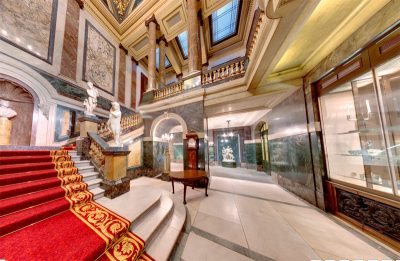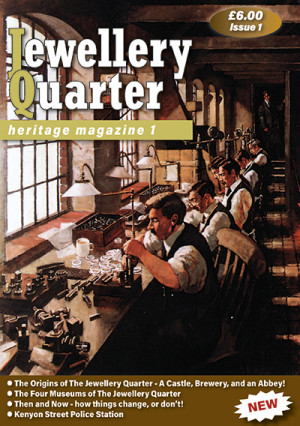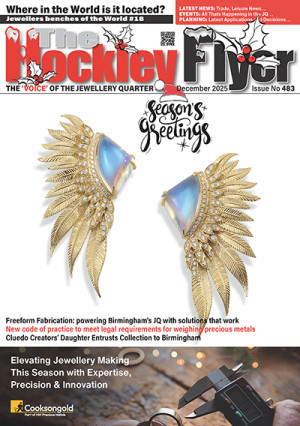 Goldsmiths’ Fair 2010 more than endorsed its long-standing and distinguished reputation as the premier show of its kind in Europe when it closed its doors on Sunday evening October 10.
Goldsmiths’ Fair 2010 more than endorsed its long-standing and distinguished reputation as the premier show of its kind in Europe when it closed its doors on Sunday evening October 10.
Over the two previous weeks 161 jewellers and silversmiths from all around the country presented their latest collections and impressed thousands of visitors with their talent and skill.
Paul Dyson Director of Promotion said: “The Fair goes from strength to strength! Buying and commissioning at this year’s Fair was extremely buoyant and proved that the interest in and appreciation for innovative, design-led, high-quality, hand-crafted jewellery and silver is not only strong but on the increase.
In general we are also finding that visitors to the Fair are discerning, well-informed and keen to learn more about the skills and techniques used by the craftsmen which in the current economic climate is extremely positive.”
The Fair continues to attract a national and international audience with ever-increasing numbers from overseas, many travelling specifically to attend the Fair. Support from past-patrons and returning visitors remains high boosted by a growing numbers of new visitors attending for the first time.
The broadening interest in the Fair can be attributed to the hard work and initiatives of the Company’s promotions team who constantly strive to raise the profile and awareness of the Fair not only through a targeted press and marketing campaign but also its audience development events.
The Fair was widely advertised through London’s tube network as well as on Classic FM and attracted press attention throughout the UK and from as far afield as the Far East. Competitions and reader events were organised and, during the Fair, in addition to the regular Past-Patrons evenings, which remain hugely popular, highly successful evenings were held with NADFAS (National Association of Decorative and Fine Arts Society), London City Guilds and Livery Companies, Barclays Wealth and Square Mile Magazine.
The offer of cream-teas to past patrons, a new initiative which was introduced last year was expanded due to its great success and 800 number of people enjoyed a delicious plate of sandwiches and cakes in the Fair’s café. The café continues to play an important part in the general enjoyment of a visit to the Fair.
Other highlights of the Fair included a book-signing event with Carol Woolton, Jewellery Editor of Vogue, who attended the Fair in Week One to sign copies of her recently published book ‘Fashion for Jewels – 100 years of Styles and Icons’.
Most importantly a large number of purchases took place with many exhibitors achieving record sales both in terms of volume and takings. Among these was Fair veteran Martyn Pugh who has exhibited at every Fair since it started. He said: “I had my best Fair ever! In my opinion there is a definite increase in the awareness and appreciation of craftsmanship and artistry. People are now making focused decisions to buy pieces of lasting value and significance.”
Jeweller Jane Adam, who exhibited in Week Two, also set a new total for sales at any show she has done to date! Jane, a leading figure in British contemporary crafts, established an international reputation for her jewellery in dyed aluminium but has more recently begun to work in gold and silver, often incorporating precious and semi-precious stones.
This was only Jane’s third Fair but she said: “I feel I have now come of age at Goldsmiths’ Fair!” She attributes her success to the fact that her pieces are striking, sophisticated, modern, extremely wearable and can be dressed up or down. Her price range she feels is another important contributory factor – pieces start from £140 up to around £1,000.
In terms of trends, rose gold made a noticeable appearance on many jewellers’ stands and proved popular with buyers. Mikala Djorup said: “It has been rather out of favour so hasn’t been seen around for a few years but now jewellers are starting to use it again, this time in a very contemporary way and people like the results.”
David McCaul agreed: “It has a warmer, softer hue than yellow gold and hence is very forgiving and suits many skin tones which adds to its appeal.” In general gold jewellery – of all carats and in all shades – was more than holding its own despite its price being at an all-time high.
Turning to silver there was a particularly strong and impressive showing of particularly innovative and original work, which not only attracted considerable attention but also resulted in substantial sales and commissions. Andrew MacGowan for example took numerous commissions for his simple but original three stand egg-cups but also sold his striking centrepiece and several other big pieces. Alex Ramsay also had a very strong fair and sold several of her stunning double skinned pierced fine silver bowls. She said: “Buyers seem to have more confidence these days and are prepared to invest in important and significant pieces.”
A number of silversmiths were exhibiting for the first time such as Kevin Grey, Adi Toch, Susan Beale, Karina Gill, James Dougall and Edward Mahony. The latter was chosen by Jacqueline Gestetner, a long-time supporter of Goldsmiths’ Fair and a passionate collector of contemporary jewellery and silver, as winner of the Best New Design Award Week Two. All of Edward’s pieces are handmade and to stress this he often leaves and even exaggerates the raising marks and uneven rims. Seams in his silver and steel pieces are soldered with a contrasting 18ct gold solder which he deliberately allows to ‘flood’ so that the seam remains visible. The effect is striking and vibrant.
The winner of the Best New Design Award in Week One was jeweller Jonathan Boyd, selected by design-authority Peter Ting. Using several forms of new technology as well as traditional hand crafting techniques, Jonathan’s jewellery makes words and text come alive. Brooches, rings, and other pieces of jewellery are made up of tiny pieces of type-face from oxidised silver combined either randomly or in an order to spell out a word or message. Jonathan, a graduate of London’s Royal College of Art, was one of 10 recent “rising star” graduates chosen to receive a free stand and a bursary from the Goldsmiths’ Company at this year’s Fair.
The scheme was initiated in 2000 as part of the Company’s ongoing strategy to encourage and support the next generation of jewellers and silversmiths. Successful candidates not only get a free stand but are given a £1,500 bursary to help them prepare. They are also offered the opportunity to take out an interest free loan of up to £3,000 from the Company to purchase bullion, through an arrangement with Cookson’s Precious Metals who supply the graduates with bullion.
Jonathan said: “Exhibiting at Goldsmiths’ Fair has been both a privilege and a fantastic experience. In talking to visitors I have gained invaluable feedback to my work.” This feeling was reiterated by all the other ‘rising star’ graduates at this year’s Fair including include jewellers Jessica Poole, Milena Kovanovic and Ros Millar and silversmiths Phil Jordan, Samantha Moore, Victoria Coleman, Susan Dunford and Karen Simpson.
Aside from the high quality of the craftsmanship on display, one of the most appealing factors about Goldsmiths’ Fair, is the sheer diversity and originality of all the work, and in particular the broad price range of items making the Fair accessible to all budgets. For example first time exhibitor Melanie Ankers did a roaring trade in her attractive, versatile silver stud earrings which started at a mere £20.
The Goldsmiths’ Company is home to the London Assay Office and one of the important criteria for exhibiting at the Fair is that all the jewellery and silver bears an appropriate hallmark.
During the Fair a mini-Assay office was set up on the first floor and members of the London Assay Office were on hand to explain to visitors the history of hallmarking and its relevance today, as well as giving demonstrations of the different ways of testing precious metals and applying hallmarks. Not surprisingly this additional educational element to the Fair proved extremely popular.
For the exhibitors themselves the Fair is a hugely important event. Apart from the opportunity of selling and a means of them gaining vital feedback to their work, it gives them access to thousands of potential new clients. Pamela Rawnsely sums it up: “I do a year’s worth of networking in one week”. Spending time with other makers is also a plus point and one that exhibitors relish.
As jeweller Ingo Henn explains: “We all have the same hopes and aspirations and face the same issues so it is invaluable that in between talking to clients and after the Fair closes we are able to share our experiences and provide each other with support.” To the outside world the Fair presents the unified face of the trade.



